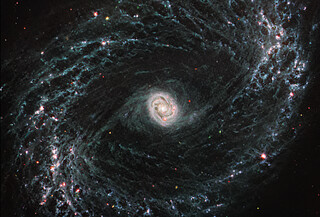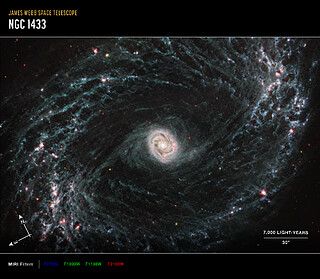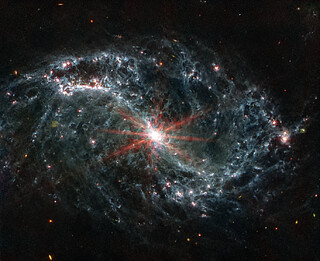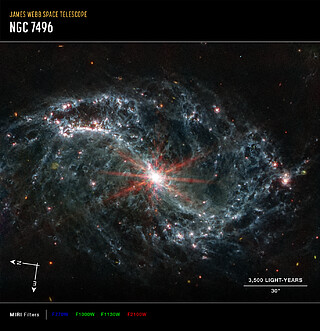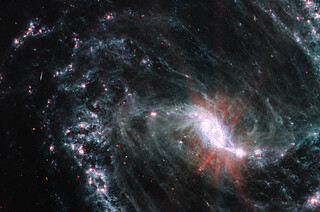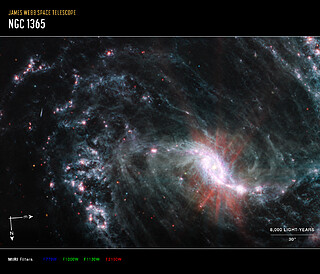weic2306 — Photo Release
Webb Reveals Intricate Networks of Gas and Dust in Nearby Galaxies
16 February 2023
Researchers using the NASA/ESA/CSA James Webb Space Telescope are getting their first look at star formation, gas, and dust in nearby galaxies with unprecedented resolution at infrared wavelengths. The data have enabled an initial collection of 21 research papers which provide new insight into how some of the smallest-scale processes in the Universe — the beginnings of star formation — impact the evolution of the largest objects in our cosmos: galaxies.
The largest survey of nearby galaxies in Webb’s first year of science operations is being carried out by the Physics at High Angular resolution in Nearby Galaxies (PHANGS) collaboration, involving more than 100 researchers from around the globe. The Webb observations are led by Janice Lee, Gemini Observatory chief scientist at the US National Science Foundation’s NOIRLab and an affiliate astronomer at the University of Arizona in Tucson.
The team is studying a diverse sample of 19 spiral galaxies, and in Webb’s first few months of science operations, observations have been made of five of those targets — M74, NGC 7496, IC 5332, NGC 1365, and NGC 1433. The results are already astounding astronomers.
The images from Webb’s Mid-Infrared Instrument (MIRI) reveal the presence of a network of highly structured features within these galaxies — glowing cavities of dust and huge cavernous bubbles of gas that line the spiral arms. In some regions of the nearby galaxies observed, this web of features appears built from both individual and overlapping shells and bubbles where young stars are releasing energy.
The high-resolution imaging needed to study these structures has long evaded astronomers — that is, until Webb came into the picture. Webb’s powerful infrared capabilities can pierce through the dust to connect the missing pieces of the puzzle. For example, specific wavelengths observable by MIRI (7.7 and 11.3 microns) are sensitive to emission from polycyclic aromatic hydrocarbons, which play a crucial role in the formation of stars and planets. These molecules were detected by Webb in the first observations by the PHANGS programme.
Studying these interactions at the finest scales can help provide insights into the larger picture of how galaxies have evolved over time.
The PHANGS team will work to create and release datasets that align Webb’s data to each of the complementary datasets obtained previously from the other observatories, to help accelerate discoveries by the broader astronomical community.
The research by the PHANGS team is being conducted as part of the General Observer program 2107. The team’s initial findings, comprising 21 individual studies, were recently published in a special focus issue of The Astrophysical Journal Letters.
More information
Webb is the largest, most powerful telescope ever launched into space. Under an international collaboration agreement, ESA provided the telescope’s launch service, using the Ariane 5 launch vehicle. Working with partners, ESA was responsible for the development and qualification of Ariane 5 adaptations for the Webb mission and for the procurement of the launch service by Arianespace. ESA also provided the workhorse spectrograph NIRSpec and 50% of the mid-infrared instrument MIRI, which was designed and built by a consortium of nationally funded European Institutes (The MIRI European Consortium) in partnership with JPL and the University of Arizona.
Webb is an international partnership between NASA, ESA and the Canadian Space Agency (CSA).
Image Credit: NASA, ESA, CSA, and J. Lee (NOIRLab), A. Pagan (STScI)
Links
- Collection of Webb’s First Images
- ESA Webb Seeing Farther Interactive Brochure
- Release on STScI website
- Release on NASA website
- Release on ESA website
- Science Paper
Contacts
Bethany Downer
ESA/Webb Chief Science Communications Officer
Email: [email protected]
Ninja Menning
ESA Newsroom and Media Relations Office
Email: [email protected]
About the Release
| Release No.: | weic2306 | |
|---|---|---|



